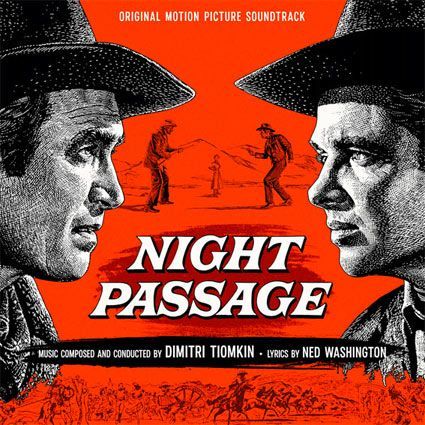The View from Pompey’s Head

Label: Film Score Monthly
Catalogue No: FSMCD Vol. 4 No. 15
Release Date: 2001
Total Duration: 74:34
UPN: 0638558003824
Also contains music from: Blue Denim
If anyone neeads proof that Elmer Bernstein and Bernard Herrmann are among the greatest film music masters, then this disc should provide it. It contains the scores for two lesser-known films from the 1950s. Both scores have more to offer than the films themselves, yet the scores don’t call attention to themselves in any overindulgent way. They also have something else in common: both films were directed by Philip Dunne. He had been an admirer of Herrmann ever since working with him on THE GHOST AND MRS. MUIR.
Dunne first asked Herrmann to compose the score for THE VIEW FROM POMPEY’S HEAD; however, because he was busy working on THE MAN WHO KNEW TOO MUCH, Herrmann wasn’t available and suggested Elmer Bernstein instead. In his notes, Lukas Kendall mentions that when Bernstein called to thank the irascible Herrmann, he just blurted out, “Well, if I didn’t think you were talented, why would I have recommended you?”.
THE VIEW FROM POMPEY’S HEAD is a term used for social prejudice in a small town in the American South. The 1955 film starred Richard Egan, Dana Wynter, Cameron Mitchell, and Sidney Blackmer. Bernstein’s score provides a perfect background to the drama. It’s brimming over with lush, romantic music. This is apparent in the opening “Main Title”, which begins with a broad and sweeping theme for strings and brass, like Alfred Newman might have composed, evoking the locales of Tamburlaine island (mostly dark and moody woodwinds) to New York City (a bright brassy Gershwin-like orchestration). The second track, “Dinah’s Theme,” is a lovely nostalgic combination of woodwinds and strings to depict Anson Page (Egan) upon his return to Pompey’s Head and his reminiscences of saying good-bye to Dinah Bradford (Wynter).
Bernstein has admitted that he wrote this theme in admiration for Dana Wynter’s beauty and talent “Mulberry” depicts Page’s reflections on his hometown and sets up a variation to the opening Pompey theme. Following a few more tracks of soft reflective music, Bernstein breaks forth with a folksy theme for “Homecoming” when Page returns to his hometown, and “On the Road to Tamburlaine,” with its Coplandesque rhythmic vitality in the horns, woodwinds and strings. Perhaps the best of all the cues, “Forever Dinah,” begins with a rather snappy quote of the Pompey theme that is slowed down to a melancholy statement of the theme, particularly in clarinets and strings. This is pure unadulterated music of great beauty.
Some may complain that the Pompey theme appears too often, but I didn’t find it tiring because it’s developed in such a way that it highlights the situations of the drama. In “Revelation,” where Garvin Wales (Blackmer) reveals that his mother was “a colored person”; this dramatic scene is accompanied by darker instruments, the oboe and violas, which are also used in the next cue, “Twilight,” when Dinah tells her husband, Mickey (Mitchell), that she wants a divorce. That leads to the “Finale,” where first the Mulberry and then the “Main Title” themes are heard. This ends on a mood of quiet resignation as Page leaves Dinah and her town of Mulberry.
BLUE DENIM is from 1959 and might easily be termed VERTIGO II, since it carries so many of the same Herrmann techniques over from that Hitchcock classic. In his album notes, Kendall describes it this way: “As in much of his other film work, the score relies on sequential patterns to generate its lyrical melodies, and draws on many of the Wagnerisms that distinguish his score to VERTIGO…Many moments anticipate his score for the TWILIGHT ZONE episode ‘Walking Distance,’ which has become one of Herrmann’s most admired creations.” If he means Herrmann’s use of leitmotifs for “The Boy” (Brandon DeWilde) and “The Girl” (Carol Lynley), and also the lush orchestration, then I would agree about the “Wagnerisms”.
Despite the strong similarities to VERTIGO, this is an outstanding score on its own. As in the Hitchcock film, Herrmann leads off BLUE DENIM with a swirling orchestral “Prelude,” which then moves on to a slower and darker sounding waltz for the theme associated with “The Boy,“ an appropriately playful theme for “The Playroom,” and then finally the “The Girl,” a slow lush theme relying heavily on the strings and woodwinds. In “Adoration,” the similarity to VERTIGO is especially apparent, with a yearning theme for strings and a few woodwinds.
This is a disc with two master film composers, who not only admired each other’s work. but also brought great distinction to what they wrote for these somewhat obscure films from the 1950s and the album is recommended to any listener who wants to hear what was going on in the glory days of Hollywood film scoring.
Roger Hall – Originally published in Soundtrack Magazine Vol. 21 / No.81 / 2002



